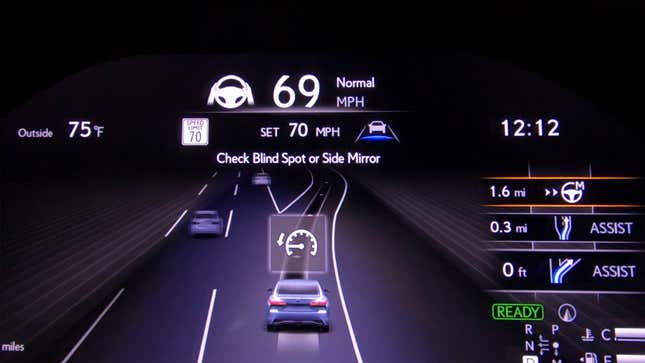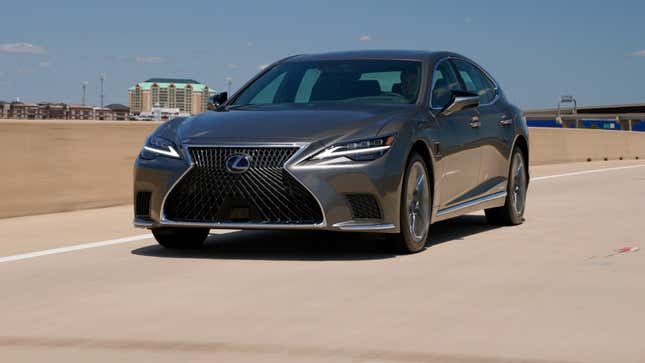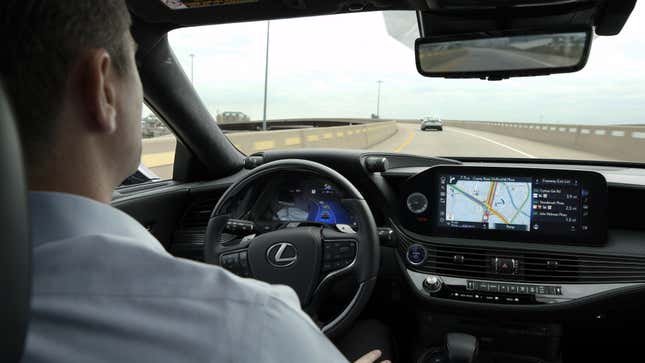Automakers have been keen on rolling out advanced driver assistance systems in their cars left and right—but the industry has run into a problem. How do you give one of these systems a catchy name without overstating the abilities of that system? Lexus Teammate, an SAE Level 2 driver assistance system, shows how it’s done.
Before we get started, it’s important to look at the other options on the market so we can actually understand what makes Teammate work. We’ll start with the most obvious one: Tesla’s Autopilot and Full Self Driving systems. Whatever you feel about the actual function of them, these names overstate the capabilities of the technology in question. The car cannot drive itself. It is not on autopilot. It still requires a significant amount of human attention and input, which Tesla does clearly explain in other places—but it’s not clear in the name.
Even Ford’s upcoming BlueCruise or Cadillac’s SuperCruise have their own faults. They do imply that they only provide some enhanced cruising capabilities, but they’re also kind of opaque and brand-y.

Teammate, though, is nice. It gives you the very clear sense that this whole driving thing requires input from both parties, driver and car. I think it would be more accurate if it was called, like, Lexus “I Did The Heavy Lifting On This Group Project But You Helped Format The Presentation So I Guess I’ll Put Your Name On It When We Turn It In,” but that’s a bit unwieldy. You, the driver, are still doing most of the work, but Lexus Teammate will come in to give you a hand in certain instances.
Teammate is projected to be part of the 2022 Lexus LS 500h, which means you’ll be able to use it soon—but it does come with some limitations. Right now, you can only use Teammate on certain limited-access highways, like toll roads. It’s only available in the United States, so if you make frequent trips across the border, Teammate won’t follow. And it’s only available on the LS 500h; Lexus intends to introduce Teammate to a wide range of products, but it wouldn’t provide a timeline. The whole purpose is to consistently refine the data that Lexus currently possesses, since it isn’t exactly easy to develop. But for a newer form of technology, I have to say, it’s pretty damn cool.
The Tech
To make this system function, Teammate uses eight cameras, five radars, and a laser to gather info on the road around the car. Some of those sensors and cameras are the standard ones you’d get from a normal safety package that monitors things like blind spots. In this case, though, the extra tech helps to collate info about all the other cars on the road, accurately evaluate speed and following distance, recognize road signs, and more.

How It Works
Teammate is a fairly intuitive system—once you get a tutorial. I wouldn’t have wanted to try to figure this out on my own, since there’s a bit of a process and a few quirks to the system right now. It makes sense once you know what you’re doing, but this is not a thing I’d want to discover all on my own.
I received instructions from some folks at Lexus, and they were fairly simple:
- On a limited-access highway, a notification will pop up on your dashboard that reads “Vehicle Position Initializing.”
- Once your car position has been located, you’ll receive another message that says, “Advanced Drive Ready.”
- When you’re ready, press the Advanced Drive button on your steering wheel. It’s the top right button on the right hand side.
- At that point, the color of the road will let you know what to do. If the road is blue, you can let go of the steering wheel. If it’s gray, then you need to have your hands on the wheel.
The system consistently prompts you to let you know what it’s going to do next and what it needs to do. If you want to merge, for example, you can have the car do it for you by pushing the turn signal stalk halfway down. Teammate will ask you to check your blindspot and won’t initiate the merge until you do. If it’s been a while since you’ve had your hands on the wheel, it’ll ask you to hold on for a moment just to make sure you’re still alert (the system does determine whether or not you’re alert via sensors that track your eyes, nose, and mouth—but it’s mostly just an extra bit of assurance). If you don’t respond to the visual cue that pops up on the dashboard, the system will ask you to take the wheel; if you ignore that, it’ll tug your seatbelts. If you have navigation on, a series of prompts will pop up on the right side of the dashboard. They’ll let you know what moves the car is going to make on its own and if it’ll need you to take control again.

If at any time you want to take control, you can do so in a few ways: depressing the accelerator, braking, turning the wheel, pushing the turn signal all the way down, or just turning off Advanced Drive mode.
Once I had someone show me the ropes, I found the system pretty easy to get used to, but part of my confidence admittedly came from the fact that I had someone sitting in the passenger seat that could answer all my questions and tell me where I needed to go. Some other journalists who tried the system did struggle because it didn’t feel intuitive to them, but it did to me—possibly because the Advanced Drive button on the steering wheel was the same as the cruise control on my Mazda and I didn’t have any engrained expectations about what an SAE Level 2 driver assist system would be.
But I think the thing I liked about it was that I lacked expectations. The name “Teammate” let me know right off the bat that I’d be working with the car while it was driving me around rather than conveying the car could do things all on its own or… whatever it is that the name SuperCruise implies.
The true test, of course, will come when these cars get in the hands of consumers who may be testing Teammate without anyone there to offer instruction. But I think it’s a pretty promising start for Lexus.